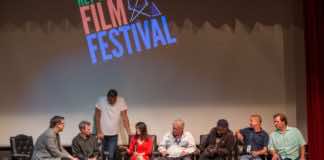
In what may be his strongest narrative documentary to date, avant-garde filmmaker Bill Morrison never sacrifices the ethos of his singular filmmaking style for a clear, powerful story. It’s a simple tale about a cache of silent era movies discovered buried in the ground of Dawson City, Canada in the ’70s but also a beautiful meditation on the impermanence of a place and a medium. The city was the end of the line of distribution for silent movies in the early part of the 20th century that were never shipped back to Hollywood and were once thought lost to time and the inherent volatility of nitrate film, which proved difficult to store, as it easily caught fire. Dawson City: Frozen Time traces the history of these movies back to the town’s founding during the Gold Rush era, which brought a boon to the region. As the population grew, people sought entertainment, hence the establishment of gambling halls, brothels (by none other than Fred Trump of that family) and a movie theater. Much of the footage is made of the “Dawson City Film Find” archive unearthed in 1978, which continues to be restored while in safe storage at the Library of Congress in the U.S. and in the Canadian Archives in Ottawa.
Most of the narrative of Dawson City: Frozen Time is provided by subtitles that trace the arrival of film and their presentation in the area while the city evolves and tries to deal with the film, which causes some intense fires in the area. But the dominant narrative is not the text and especially not a voice over or talking heads but the music by Alex Somers, a majestic, sprawling piece of melancholy that sounds like the music of Sigur Ros (Somers happens to be a longtime collaborator of the Icelandic band). Strings and piano dominate the score, but it also features occasional cooing vocals that might only be understood by Icelanders. Sometimes it distorts in accompaniment to the ravaged images of the original films. The abstraction of the music heightens several aspects of these film’s stories. A sense of tragedy haunts this documentary, from the perils of the Yukon “stampeders” who trekked dangerous mountain paths for gold dust to the many fires sparked by the storage of these dangerous films. Then there are the images of the films from 1910s, which were once thought lost to their own instability but inadvertently became preserved, forgotten in the permafrost of the location for decades.

These silent film images are often worn into indecipherable colonies of blobs at the edges of the frame. However, the narratives inside these tightened frames dictated by nature remain clear. Through his editing and efficient, brief captions, Morrison reveals the history of the city from its birth up to present-day conversations with the couple who led the excavation of the films, local historians Michael Gates and Kathy Jones-Gates. All the while, Morrison intercuts thematically different silent movies by association. For instance, there’s a montage of character entrances and another of sad or angry faces. Toward the end, there’s a beautiful sequence that redeems the imperfection of time passed and the destructiveness of it, where Morrison presents images of the actors, acting against the amorphous shapes introduced by the ravages of time, the sort of happy accidents that made his most well-known film, Decasia one of the best films of the 21st century.
Morrison’s telling of history is a blend of facts and feeling that transcends common expectations of what a documentary should be. He takes into account that Dawson was a city born out of a greed for gold. The mining not only displaced a native tribe of people called the Tr’ondëk Hwëch’in who are speculated to have lived off the land for maybe thousands of years but also sacrificed natural resources. The impact comes via only a few images, including a stunning aerial shot across the rippled desolate landscape left behind by the mining companies. Morrison also never points a finger of blame. When it is revealed that the city routinely disposed of garbage including films that were too expensive to ship back to Hollywood in the Yukon river, it’s revealed as a fact of life then, which can only be judged with perspective from today. Dawson City: Frozen Time is ultimately a celebration of time. It both captures a moment in time but also time’s sprawling transformational power. As it presents the history of early cinema by way of a city for which film was so important, Dawson City: Frozen Time also celebrates the essence of the medium of film.
Dawson City: Frozen Time runs 120 minutes and is not rated. It opened in our Miami area exclusively at the Miami Beach Cinematheque this past Friday. It will then play the Key West Film Festival on Nov. 18. For screenings in other parts of the U.S., visit this link and select “playdates.” Kino Lorber sent us an online screener for the purpose of this review.









